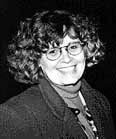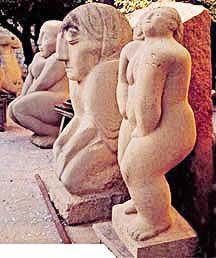|

Summer
1999 (7.2)
Page
11
Editorial: Colors
of the Century
An Artistic
Perspective
by
Betty Blair
  As many of you know,
the drive between Baku's airport and the city itself can be rather
disconcerting. For miles, you pass nothing but desolate landscapes
with soil so saturated with oil that nothing grows. Rusty "nodding
donkeys", like mindless robots, stand isolated and neglected,
forever pumping that black sticky oil from the belly of the earth.
More than once I've asked myself, "What am I doing in this
God-forsaken place? Is this the "real Azerbaijan"? As many of you know,
the drive between Baku's airport and the city itself can be rather
disconcerting. For miles, you pass nothing but desolate landscapes
with soil so saturated with oil that nothing grows. Rusty "nodding
donkeys", like mindless robots, stand isolated and neglected,
forever pumping that black sticky oil from the belly of the earth.
More than once I've asked myself, "What am I doing in this
God-forsaken place? Is this the "real Azerbaijan"?
This past year, a considerable number of foreign journalists
from major media have traveled this same route on assignment
to this "exotic", little-known, often mispronounced,
dot on the world's map. They "parachute" in to Baku
for a few days, hang out at the foreign pubs, and spend most
of their time with others who speak their same language. In the
blink of an eye, they're heading back home, story in hand, assignment
complete, eager to move on to the next reality. In the name of
"objective reporting", their analyses usually turn
out to be as superficial as the thin film of dirt that settles
everywhere over the city everyday.
Such an approach to news could be viewed as the flip side of
the same coin that Soviet officials imposed on Art policy for
most of this century. Both deal primarily with the illusion of
physical appearances.
While international
journalists tend to paint a picture of desolation, misery and
depression with little hope of recovery except through the great
panacea of oil, Social Realism mandated that artists paint life
full of eternal optimism, images of courage, confidence and determination.
Photo: Works by Azerbaijani
sculptor Fazil Najafov.
  Azerbaijani sculptor
Fazil Najafov (page 60) was not the only art student denied a
university degree from Moscow for challenging this vision of
the socialist system. His final project in 1961 depicted exhausted
oil laborers leaning up against a pipeline. But Soviet workers
weren't supposed to look fatigued. Labor was to be glorified
and work romanticized, and Fazil returned to Baku empty-handed
without a diploma. Azerbaijani sculptor
Fazil Najafov (page 60) was not the only art student denied a
university degree from Moscow for challenging this vision of
the socialist system. His final project in 1961 depicted exhausted
oil laborers leaning up against a pipeline. But Soviet workers
weren't supposed to look fatigued. Labor was to be glorified
and work romanticized, and Fazil returned to Baku empty-handed
without a diploma.
Of course, as in every population on earth, there were, still
are, and always will be, those who succumb to the gods of ideology,
whether it be despotism, tyranny, commercialism or whatever.
After all, artists need to eat just like the rest of us. That's
why countless paintings were dedicated to the glories of the
proletariat in the Soviet republics. In Azerbaijan, they took
the shape of sinewy, tough oil workers and sun-toughened collective
farmers.
In this issue "Colors of the Century - An Artistic Perspective",
we've left out most samples of Social Realism with the one exception
of Tahir Salahov, an immensely gifted artist, who found ways
to paint in a realistic style without always making everything
"rosy".
Here we've focused primarily on major personalities who have
given modern art its distinctive Azerbaijani signature. Unlike
writers who were killed for their quest for freedom, dissident
artists were simply ostracized and their works simply not included
in exhibitions [See Century of Reversals, AI 7.1]. And so artists
of conscience suffered from not being assigned projects - no
work, no bread - and were left at the mercy of the good will
of othersalong with cheap cigarettes and too much alcohol. It's
our great loss that most of these extraordinary artists did not
live to celebrate their 70th birthday.
Starting in the late 1950s and 60s, what is now referred to as
the "Absheron School" formed the ideological basis
for Azerbaijan's modern art movement. East from Baku on the peninsula
that comprises the "eagle's head" of Azerbaijan's map,
there is a small village called Busovna where this movement got
started in a run-down dilapidated cottage. Javad Mirjavad was
its driving force.
The movement was given birth while he was studying in Leningrad.
Javid had learned that numerous paintings from European Impressionists
and Post-impressionists, along with the African and Mexican works,
were not exhibited at the Hermitage Art Museum but kept in their
storehouses while the KGB "kept tabs" on anyone showing
too much interest in such approaches to art.
One day Javid decided to approach the Director of the Hermitage
determined to get a look for himself. As the story goes, he first
went out and "got himself tipsy" and then half jokingly,
half seriously, threatened the Director: "Either you give
me permission to go into the storerooms or I'll kill you."
The Director understood Javid's passion and replied, "What's
the use of killing me, just go and sit there as long as you wish."
And so for several months, Javid explored the storehouse, marveling
at the works that were denied the public.
Transformed by what he saw, Javad set fire to all of his own
works, destroying everything (see page 31). Then, he returned
to Azerbaijan to start anew. Gorkhmaz Afandi, Kamal Ahmad, Rasim
Babayev, Hamza Abdullayev, Fazil Najafov and Farhad Khalilov
were among those who followed him over the course of several
years.
The Absheron School has its own distinct characteristics. Works
are passionate, provocative, often enigmatic, and always highly
political. They are deeply infused with strong colors emblazoned
by the harsh rays of the Absheron sun. Forms are exaggerated
and works aren't necessarily "pretty"; they bite and
kick and scream in their attempts to counter the Establishment.
This is the legacy that young artists who paint and sculpt in
Azerbaijan today have been influenced by.
In our modern world of satellite communication in which we have
instant access to view events happening even in remote places
on the other side of the earth, one might ask whether we need
artists anymore. In past centuries, much artwork was descriptive
of customs and traditions. But now with such a proliferation
of recording equipment, both oral and visual-tape recorders,
cameras, videos, scanners and the Internet - who needs artists
anymore?
The genuine Artist would reply, "You need me because I show
you things invisible to the naked eye - both beautiful and hideous.
I bring perspective, social and psychological context and interpretation.
I dream of how things could be and at the same time I writhe
in pain at the wrongs and evils of our day." And it is exactly
for this reason that we need artists just as much as they need
us.
It's no secret that Azerbaijanis artists are struggling these
days just as everyone else in the Soviet Republics who are trying
to make the transition into the world market economy. It's for
this reason that we've included the artists' contact numbers
here, hoping that some art lovers will initiate relationships
and friendships. If you don't know Azeri or Russian, find a friend
to make the initial contacts for you. You'll be deeply enriched.
In the meantime, we'd like to challenge journalists and visitors
alike who suddenly find themselves landing at Baku's Airport
to check out the country's "invisible" landscapes -
as envisioned by its painters and sculptors, its writers, dramatists
and musicians. If you're really determined to understand this
country, don't take all your clues from the desolate landscape
that lines the route between the airport and your five-star hotel.
From Azerbaijan
International
(7.2) Summer1999.
© Azerbaijan International 1999. All rights reserved.
Back to Index
AI 7.2 (Summer 1999)
AI Home
| Magazine
Choice | Topics
| Store
| Contact
us
|


